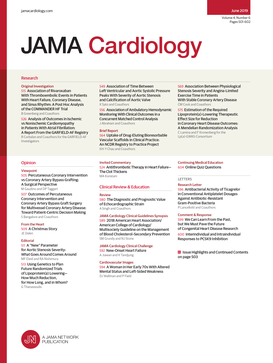累积生命基本8分与心血管疾病风险
IF 14.8
1区 医学
Q1 CARDIAC & CARDIOVASCULAR SYSTEMS
引用次数: 0
摘要
大多数关于心血管健康(CVH)与心血管疾病(CVD)和死亡率之间关系的文献都依赖于单一的中年测量。了解累积CVH如何随时间影响晚年CVD和死亡率可能有助于早期预防。目的确定累积CVH(由美国心脏协会生命基本8 (LE8)从18岁到45岁测量)是否与中年心血管疾病发病率和死亡率相关。设计、环境和参与者这项队列研究,即年轻人冠状动脉风险发展(CARDIA)研究,收集了1985年至2020年美国4个中心参与者的CVH数据。多变量Cox比例风险模型评估了(1)四分位数累积LE8评分、(2)45岁累积LE8评分和评分、(3)18 - 45岁累积LE8评分和LE8评分斜率与45岁后心血管疾病发病率和死亡率的关系。主要结局和测量:心血管疾病发生率和全因死亡率。累积LE8评分计算为18 - 45岁期间LE8评分(0-100,CVH越高越好)曲线下面积。结果4832例CARDIA患者(女性2690例(55.7%),男性2142例(44.3%)),18 ~ 45岁平均累积LE8评分为2018.8(95.0)点×年。与四分位数1 (Q1,即最低CVH)相比,Q2、Q3和Q4的CVD风险显著降低(Q2 HR, 0.44;95% ci, 0.32-0.61;Q3小时,0.26;95% ci, 0.18-0.38;Q4小时,0.12;95% CI, 0.07-0.21)和死亡率(Q2 HR, 0.51;95% ci, 0.36-0.71;Q3小时,0.38;95% ci, 0.26-0.55;Q4小时,0.29;95% CI, 0.18-0.45)。当18岁至45岁的累积LE8评分和45岁时的LE8评分一起纳入模型时,两者都与心血管疾病风险降低显著相关。同样,从18岁到45岁的累积LE8评分和LE8评分的正斜率(改善)与45岁后发生心血管疾病的风险降低显著相关。结论和相关性青年期CVH的累积和改善,以及中年期CVH的改善,都与中年期CVD发生风险的降低独立相关。这些结果强调了维持和改善整个青年期CVH的重要性。本文章由计算机程序翻译,如有差异,请以英文原文为准。
Cumulative Life’s Essential 8 Scores and Cardiovascular Disease Risk
ImportanceMost literature on the association between cardiovascular health (CVH) and incident cardiovascular disease (CVD) and mortality has relied on single midlife measurements. Understanding how cumulative CVH over time influences later-life CVD and mortality may aid early prevention.ObjectiveTo determine whether cumulative CVH, as measured by the American Heart Association Life’s Essential 8 (LE8) from age 18 to 45 years, is associated with incident CVD and mortality in midlife.Design, Setting, and ParticipantsThis cohort study, the Coronary Artery Risk Development in Young Adults (CARDIA) study, collected CVH data for participants from 4 US centers from 1985 to 2020. Multivariate Cox proportional hazard models assessed the associations of (1) cumulative LE8 score by quartile, (2) cumulative LE8 score and score at age 45 years, and (3) cumulative LE8 score and LE8 score slope from age 18 to 45 years with incident CVD and mortality after age 45 years.Main Outcomes and MeasuresIncident CVD and all-cause mortality. Cumulative LE8 score was calculated as the area under the curve of the LE8 score (0-100, higher is better CVH) over time from age 18 to 45 years.ResultsThere were 4832 CARDIA participants (2690 [55.7%] female and 2142 [44.3%] male) with a mean (SD) cumulative LE8 score from age 18 to 45 years of 2018.8 (95.0) point × years. Compared with quartile 1 (Q1, ie, lowest CVH), Q2, Q3, and Q4 had significantly lower hazards for CVD (Q2 HR, 0.44; 95% CI, 0.32-0.61; Q3 HR, 0.26; 95% CI, 0.18-0.38; Q4 HR, 0.12; 95% CI, 0.07-0.21) and mortality (Q2 HR, 0.51; 95% CI, 0.36-0.71; Q3 HR, 0.38; 95% CI, 0.26-0.55; Q4 HR, 0.29; 95% CI, 0.18-0.45) after age 45 years. When cumulative LE8 score from age 18 to 45 years and LE8 score at age 45 years were in the model together, both were significantly associated with lower risk for CVD. Likewise, both cumulative LE8 score and positive slope of (improving) LE8 score from age 18 to 45 years were significantly associated with lower hazards for incident CVD after age 45 years.Conclusions and RelevanceGreater cumulative CVH and improvement in CVH during young adulthood, as well as better CVH in middle age, were all independently associated with lower risk for incident CVD in midlife. These results emphasize the importance of maintaining and improving CVH throughout young adulthood.
求助全文
通过发布文献求助,成功后即可免费获取论文全文。
去求助
来源期刊

JAMA cardiology
Medicine-Cardiology and Cardiovascular Medicine
CiteScore
45.80
自引率
1.70%
发文量
264
期刊介绍:
JAMA Cardiology, an international peer-reviewed journal, serves as the premier publication for clinical investigators, clinicians, and trainees in cardiovascular medicine worldwide. As a member of the JAMA Network, it aligns with a consortium of peer-reviewed general medical and specialty publications.
Published online weekly, every Wednesday, and in 12 print/online issues annually, JAMA Cardiology attracts over 4.3 million annual article views and downloads. Research articles become freely accessible online 12 months post-publication without any author fees. Moreover, the online version is readily accessible to institutions in developing countries through the World Health Organization's HINARI program.
Positioned at the intersection of clinical investigation, actionable clinical science, and clinical practice, JAMA Cardiology prioritizes traditional and evolving cardiovascular medicine, alongside evidence-based health policy. It places particular emphasis on health equity, especially when grounded in original science, as a top editorial priority.
 求助内容:
求助内容: 应助结果提醒方式:
应助结果提醒方式:


